读后续写与概要写作微技能三 如何提炼关键词
高考英语写作之读后续写、概要写作,思路
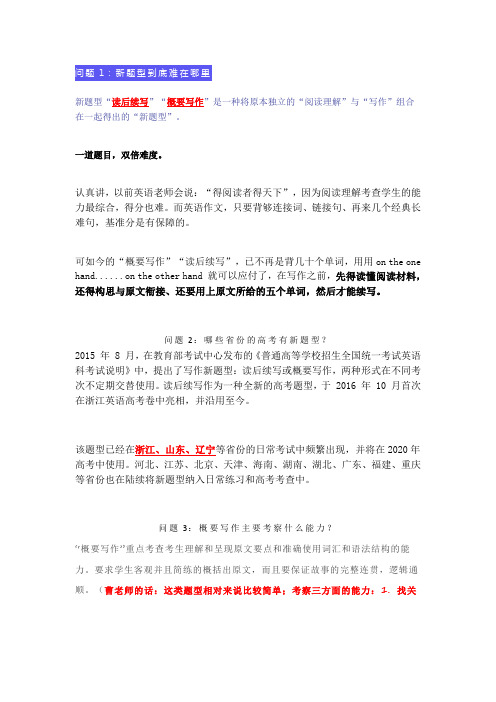
1新题型“读后续写”“概要写作”是一种将原本独立的“阅读理解”与“写作”组合在一起得出的“新题型”。
一道题目,双倍难度。
认真讲,以前英语老师会说:“得阅读者得天下”,因为阅读理解考查学生的能力最综合,得分也难。
而英语作文,只要背够连接词、链接句、再来几个经典长难句,基准分是有保障的。
可如今的“概要写作”“读后续写”,已不再是背几十个单词,用用on the one hand......on the other hand 就可以应付了,在写作之前,先得读懂阅读材料,还得构思与原文衔接、还要用上原文所给的五个单词,然后才能续写。
问题2:哪些省份的高考有新题型?2015 年 8 月,在教育部考试中心发布的《普通高等学校招生全国统一考试英语科考试说明》中,提出了写作新题型:读后续写或概要写作,两种形式在不同考次不定期交替使用。
读后续写作为一种全新的高考题型,于 2016 年 10 月首次在浙江英语高考卷中亮相,并沿用至今。
该题型已经在浙江、山东、辽宁等省份的日常考试中频繁出现,并将在2020年高考中使用。
河北、江苏、北京、天津、海南、湖南、湖北、广东、福建、重庆等省份也在陆续将新题型纳入日常练习和高考考查中。
问题3:概要写作主要考察什么能力?“概要写作”重点考查考生理解和呈现原文要点和准确使用词汇和语法结构的能力。
要求学生客观并且简练的概括出原文,而且要保证故事的完整连贯,逻辑通顺。
(曹老师的话:这类题型相对来说比较简单;考察三方面的能力:1. 找关键词的能力;2. 把关键词写成正确句子的能力;3. 把句子写成合理的段落的能力)问题4:读后续写考察什么能力?读后续写主要关注学生以下四个方面的能力:①把握短文关键信息和语言特点的能力。
学生需要了解所给短文的主要内容,清楚其关键词和语言结构的使用情况,并通过续写短文表现出来。
②语言运用的准确性和丰富性。
学生能准确、恰当地使用所学词汇和语言结构,还能够根据内容需要使用较多、较复杂的词汇和语言结构。
读后续写和概要写作讲义读后续写高分素材--微技能之细节描写

新高考读后续写高分素材--微技能之细节描写读后续写微技能之细节描写1高考中续写的文体主要为记叙文.顾名思义,记叙文主要以记叙事件为主,因此需要用到许多的细节描写以使文章生动,言之有物.不少学生语言功底不错,但是续写始终得不了高分,其中一个原因可能就是细节描写的缺乏.那么,续写该如何写呢?我们应该做到兼顾概括描述和细节描述,而且要多用细节描述.所谓概括描述是指对一个事件的总体描述,而细节描述那么是对事件的具体描述,来对之前的总体描述进一步解释说明,这样能够使得描述更加生动,有画面感.举例:如表达一个人的疲累时,可用概括描述:she felt exhausted,同时辅以细节描述She felt exhausted and sat by the stream, resting her aching feet.如果大家注意这些细节的描述,一定会为你的记叙文续写增色!“感到害怕〞的细节描述当看到那只凶恶的狼时,我感到很害怕.1、大家可以先尝试用概括描述,先将意思表达清楚.2、请你在此概括描述的根底上增加细节描述,注意逻辑关系以及语意的合理.1)___________________________________2)3)参考答案:1.At the sight of the ferocious wolf, I felt very scared.2. 1)At the sight of the ferocious wolf, I felt so scared that my throat tightened and my knees felt weak.(嗓子发紧, 膝盖发软)2)At the sight of the ferocious wolf, I froze with terror, too scared to move an inch.(P下呆了,不敢动弹)3)At the sight of the ferocious wolf, I was seized by a strong sense of horror and my palms were sweating.(被深深地恐惧感所限制,手心出汗)表感到兴奋thrilled当主持人宣布她获奖时,她兴奋极了.1、大家可以先尝试用概括描述,先将意思表达清楚.2、请你在此概括描述的根底上增加细节描述,注意逻辑关系以及语意的合理.1)___________________________________2)3)参考答案:1)When the host announced that she won the prize, she felt thrilled.2)1) When the host announced that she won the prize, her eyes twinkled with excitement.(冲动得两眼放光)3)When the host announced that she won the prize, her heart was thumping with excitement.(冲动得心砰砰跳)4)When the host announced that she won the prize, a wide excitement took hold of her.(兴奋不能自己)感到悲伤〞的细节描述一听到那个坏消息,她悲伤不已.1、大家可以先尝试用概括描述,先将意思表达清楚.2、请你在此概括描述的根底上增加细节描述,注意逻辑关系以及语意的合理.1)2)3)参考答案:1.Upon hearing the bad news, she felt extremely sad.2.1〕Upon hearing the bad news, her heart ached, tears streaming down her cheeks.〔心痛,眼泪直流〕2〕Upon hearing the bad news, she, numb with grief, had trouble speaking.〔悲伤至U失去知觉,不能开口说话〕3.〕Upon hearing the bad news, she felt seized by a burst of sadness and couldn,t help crying bitterly.被一股悲伤之感限制,忍不住哭泣〕“感到开心〞的细节描述当妈妈亲吻他时,小baby开心极了.1、大家可以先尝试用概括描述,先将意思表达清楚.2、请你在此概括描述的根底上增加细节描述,注意逻辑关系以及语意的合理.1)2)3)参考答案:1.When his mother kissed him on the cheek, the baby was happy/delighted/full ofjoy.1.1)When his mother kissed him on the cheek, it seemed as if the babywere on top of the world.〔非常开心〕2)When the mother kissed the baby on the cheek, his face beamed and his bright smile lit up the room.〔眉开眼笑;笑容照亮房间〕3)When the mother kissed the baby on the cheek, his eyes danced with joy and sweetness.〔欢欣雀跃〕〞感到羞愧〞的细节描述她感到非常羞愧.1、大家可以先尝试用概括描述,先将意思表达清楚.〔答案见底部Key 1〕2、请你在此概括描述的根底上增加细节描述,注意逻辑关系以及语意的合理.1)2)3)〔答案见底部Key 2〕参考答案:Key 1: She felt ashamed.Key 2:1)She felt so ashamed that she could feel her face burning.〔脸上滚烫〕2)So ashamed was she that she could feel the blood rush to her face.〔血液涌上脸颊〕3)So ashamed did she feel that she was close to tears.〔快哭了〕“感到生气〞的细节描述Sheldon感到非常生气.1、大家可以先尝试用概括描述,先将意思表达清楚.2、请你在此概括描述的根底上增加细节描述,注意逻辑关系以及语意的合理.1)2)3)参考答案:Key 1: Sheldon felt very angry.Key 2:1)Sheldon felt so angry that he stormed out of the room, slamming the door furiously behind him.(冲出房间;狠狠摔门)2)Boiling with rage, Sheldon shook his fist at me.(怒火中烧;挥舞拳头)3)Filled with fury, Sheldon was unable to utter a single word.(充满愤怒;说不出话)“感到绝望〞的细节描述Tony感到很绝望.1、大家可以先尝试用概括描述,先将意思表达清楚.2、请你在此概括描述的根底上增加细节描述,注意逻辑关系以及语意的合理.1)____________________________________2)3)参考答案:Key 1: Tony felt hopeless/desperate.Key 2:1)As the result of an accident, Tony was suddenly thrown into a world of darkness and sank into hopelessness.(被投入黑暗之中;陷入绝望)2)Tony felt left out and was getting desperate with loneliness.(感觉被遗忘、无视)3)Tony's beliefs in looking forward and seeing the positive in everythingdeserted him.“人的行走之态〞细节描述1、踉踉跄跄2、悄悄地走3、猛冲〔答案见底部〕Keys:1.The player lost his balance, staggered back and toppled over.这个运发动失去了平衡,向后翘趄摔倒了.2.She slipped out of bed and tiptoed to the window,她溜下床,踮起脚尖走向窗户.3. The minion made a rush for the door and escaped from the scene.小黄人向门冲去,逃离了现场.人的说话方式〞细节描述说话的方式多种多样,如果都用talk就显得索然无味,也不够准确,所以要多积累各种各样的表达.1、说长道短;八卦2、小声咕哝3、嚎叫〔答案见底部〕Keys:1.The whole company is gossiping about the reason for his dismissal.整个公司都在谈论他被免职的原因.2.He murmured against the strict rules of the reality show.他私下低声抱怨真人秀的严苛规那么.3.Treated so unfairly, shehowled in pain and anger,被如此不公正地对待,她痛苦而又愤怒的嚎叫.细节描述之“思考〞如何表达一个人暗自思索时的样子对学生来说是很困难的,大多数情况下,学生往往会选择避开,但是, 人无时无刻不在思考,强行避开会使得故事内容上有些不衔接.所以,今天我们就一起来学习一下如何表达一个人的思考神态.1.得知问题所在之后,他的大脑开始急速运转,想要想出一个好的解决方案.2,单独一人时,他总是会想到那可怕的经历.3.在他洗澡时,忽然想到了一个好主意.〔答案见底部〕Keys:1.After he knew what the problem was, his mind began to race, trying to think of a good solution.〔大脑飞速运转〕2.When left alone, he would always be haunted by that horrible experience.〔[不好的回忆]萦绕心头挥之不去〕3.When he was taking a shower, a brilliant idea suddenlycrossed his mind.〔忽然闪过某人的脑海〕细节描述之“describe a peaceful scene〞今天,我们来看看该如何描述安静祥和的场景.1,享受阳光2,山间有小屋和田地3.入暮时分,芦苇随风飘扬〔答案见底部〕Keys:1.When I was bathed in the sunlight, it felt like the amber-like sunshine was kissing every inch of my skin.〔沐浴在阳光下;琥珀色的阳光亲吻着全身的肌肤〕2.Mist-covered mountains were dotted with small farms and villages.〔点缀着〕3.The sound of my footsteps was accompanied only by the gracefully waving reeds.〔优雅地随风飘扬的芦苇〕细节描述之“describe stormy weather〞今天,我们来看看该如何描述风雨交加的天气.1,乌云密布2.劲风恶浪肆虐3.暴雨疾风〔答案见底部〕Keys:1.The sky is overcast, darkened with gloomy clouds.〔乌云密布;黑云压顶〕2.On that dark and stormy night, the waves were crashing and the winds were howling.〔海浪肆意拍打;劲风咆哮〕3.The rain came pouring down, the streams rose, and the winds blew and beat against the house.〔暴风骤雨〕读后续写对话中的常见误区□1废话连篇,无助推动情节开展,刻画人物性格.“Hey, how are you?〞 “I’m fine, how are you?〞“How is the weather?〞 “Terrific! Nice day for a walk, isn,t it?〞评析:这样的对话在现实生活中很真实,但是小说毕竟是艺术加工,无助情节推动的,不能刻画人物性格的日常应酬和偏离文章主线的对话绝对不用.2追求花哨,过度使用对话标签dialogue tags“That is fantastic news,〞 he said happily.评析:此句中完全没有必要加上一个happily来表达说的方式,由于句中的fantastic 一词足以说明说话人了表情,过度强调dialogue tags会让读者的注意力集中在“说话的方式〞而不是“说话的内容〞.建议改为:“That is fantastic news!〞 he said/screamed/exclaimed.〔一个感慨号和一个fantastic 已经足以让读者想象当时的情景.适当的“艺术留白〞也是需要的,这样会留给读者想象的空间.还有一种防止过度的dialogue tags的方法是运用“动作描写〞来取而代之.如:Her eyes reflected the candlelight as she smiled at her son.“Everyone is unique. Just follow your heart and be yourself!〞3用词不当,错误使用对话标签dialogue tags"I can't believe it," Emma gasped."That's hilarious," Henry chuckled.评析:以上两句话也是我在大量的学生习作甚至是范文中发现的.这里把动作描写和dialogue tags混淆了, 试想谁能gasp 〔喘息〕、chuckle 〔轻笑〕出一句话?除非他或她有特异功能.纠正方法如下:"I can't believe it," Emma said with a gasp.〔Question tag+ with 介词短语〕Emma gasped. "I can't believe it."〔动作描写+句号〕"I can't believe it." Emma gasped.〔对话句断+动作描写〕"That's hilarious!" Henry chuckled.〔感慨句结束+动作描写〕"That's hilarious," Henry said, chuckling.〔Question tag+分词做伴随状况〕请特别关注以上对话的标点.4多此一举,对话对象十清楚确,仍使用对话标签“I told you already,〞 I said, glaring.评析:此句貌似豪华,其实对话中的主语“1〞已经清楚地说明了说话者,完全没有必要用question tag“I said〞来说明说话对象.纠正方法:加上一点动作描写就可以防止这种错误,并且提升语言的生动性.I glared at him. “I told you already.〞5频用副词,词汇贫乏只会tell不会show“How can you do this?〞she said angrily, looking at me furiously.评析:此句也是貌似,高大上〞,使用了大量副词,并且套用了分词做伴随的句型.任何方面都有度,过之而不及.过度堆砌辞藻会让人生厌,过度使用副词也会让阅卷老师觉得你词汇贫乏,非得用副词才能表达出来. 2大纠正方法:1〕积累相关的show的词汇来防止过度使用副词2〕穿插动作描写辅助对话,刻画人物心情试比拟以下两句:“That,s not what you said yesterday,〞 she said, her voice implying she was withdrawing.“That,s not what you said yesterday.〞She hesitated, turned and walked to the window.评析:两句话粗看都是相当不错.无论从词汇和语法结构的使用似乎都属于上乘之作.但细细琢磨下面这句反而更高一筹.原因是,第一句用了imply和withdraw两词来tell说话者she的心情,而第二句hesitate和后面的动作描写让她的犹豫心情跃然纸上.小说故事要的就是这种show的方式.分析对话实例,揭示对话秘诀Example 1原文内容:作者爸爸在阳台种植康乃馨,悉心呵护,作者一家都非常喜欢这些花.爸妈再三强调不允许作者和他姐姐不能触碰这些花.To our surprise, Dad was mad about it, yelling at us, “ Don,t you know touching is not allowed? Wha t on earth have you done?〞赏析:反义疑问句和on earth的使用增强了语气,凸显了父亲的生气.Example 2原文内容:母亲去世,哥哥外出.父女相约吃饭,引发了女儿对母亲和哥哥的思念,父亲读懂了女儿内心的想法,抚慰女儿.母亲在天堂一定希望他们过得快乐,现在他们需要做的就是珍惜身边的人.Seeing this, my father lovingly held my hands and said to me, “Sweetheart, I believe your mother must want you to live happily, so say goodbye to the past and embrace the present. Your brother and I will always be with you.〞赏析:情感类的对话要求感人,触及内心,这点此对话做的不错.但是小编也要对此对话提出点意见1〕文中的and said to me完全没有必要,由于对话对象非常清楚,肯定和我说.2〕your mother显得太疏远,亲人间相互称呼用Mom即可,更显真实,贴近生活.Example 3原文内容:作者家忽然停电,虽然弟弟觉得停电时间非常无聊,但是作者却非常享受停电时间,享受‘没有现代电子科技带来的干扰〞的宁静片刻.Bzzz! The lights return. " Yeah, no more candles!〞 My mother yells, pulling me away from my fantasy.赏析:对话简洁自然,表达了说话者恢复用电时候的兴奋,对话外面的dialogue tag也很出色,分词的使用既丰富了语言也推动了情节的进一步开展.Example 4原文内容:主人公Jenny通过自身的劳动获得了心爱的项链,形影不离.父亲每日给她讲睡前故事.父亲成心试探女儿,问是否可以把项链给他.Jenny深爱爸爸但不舍自己努力得来的项链.A week later, her father once again asked Jenny after her story. “ Jenny, you love me, don,t you? Give me your pearls, okay? “ Daddy, why must you ask for the pearls?〞 Jenny refused again. “ Not only did I finish all those chores, but also I spent the dollar bill given for my birthday just to pay for it.〞They both fell into silence. Then her father smiled, comforting her with a warm hug. “ That,s okey, darling. Goodnight.〞Several days later, when Jenny,s father came in to read her a story as usual, he was surprised to find something under the story book, which turned out to be the necklace. “ Daddy, now you can have it.〞 Jenny raised her head, “ You know, I love you.〞 Her father was moved beyond words. Slowly, he pulled something out of his pocket. It was a pretty necklace with real pearls shining. “The more you are willing to give, the more you are likely to receive. That,s the real meaning of sharing and giving.〞 Her father h elped Jenny put on the necklace . “ You know, I love you, little one.〞赏析:此文运用了大量的对话,主要是考虑到与前文的协同.大量的父女间的对话穿插一些旁白或动作描写很好地刻画了人物之间的冲突,细腻生动地刻画了人物心情.一般的读后续写不建议用太多的对话.适当的对话可以打破单调,推动情节,刻画人物性格.对于此文中的对话,小编也想提出点个人的意见:1) “ Not only did I finish all those chores, but also I spent the dollar bill given for my birthday just to pay for it.〞此匕句似乎为了使用not only…,but also的倒装句型而写对话,显得很不自然.语句太长反而不能表达小女孩当时的生气.建议改为:“It,s mine! My efforts!〞反而显得简洁自然,同样到达了效果,符合人在生气时候的说话方式:短句!不完整句!2)还有一处标点的使用也有误.请看:Jenny raised her head,此处的逗号要改为句号.只能作为动作描写,而不是question tag.Example 5原文内容:这是一个哲理故事,讲述一位商人儿子去向智者寻找快乐秘诀.智者让年轻人带着两汤勺油绕城一周不能将油洒落.智者待年轻人回来后问他是否欣赏到城堡的美景,年轻人哑口无言.然后智者重新让这年轻人带着两勺油绕城一周,结果……“ But where are the two drops of oil I gave you?〞 asked the wise man. Embarrassed again, the young manapolo gized, “ I had forgotten the sp totally. My only concern was the attractive sights.〞 “ But you have got the happiness.〞 Smiled the wise man...“ But where are the two drops of oil I gave you?〞 asked the wise man. He lowered his head and found that there wa s nothing left in his spoon, astonished and embarrassed. Then the wise man smiled generously, “I don't blame you. I just want you to realize the secret of happiness yourself. Now, could you tell me about your thoughts?〞 The young man thought for a while an d slowly replied, “ the truth of happiness is holding our dreams tightly but never failing to watch the beautiful scenery around us.〞赏析:此文的对话主要是用来揭示故事的寓意,通常出现在故事的末尾.这样的对话一定要写出深度厚度, 才能博得老师的高分.建议可以使用强调句.此文中也有一个标点瑕疵.请看:Then the wise man smiled generously,此句的逗号也要改为句号,作为动作描写穿插其中,而不是question tag.他山石可攻玉|这些“恐惧〞情绪的表达你都用过吗?一篇出自美国初中生的看图说话与2021年6月浙江英语高考“读后续写〞酷似!Write a short story based on the pictures below in not less than 100 words.One weekend, my parents decided to bring my brother and I to the recreational jungle. We were very excited as we had not been there before. My brother and I talked about all the bears, tigers and reindeer we were going to see. We really thought that a recreational jungle was like any other jungle.When we arrived, we dashed into the jungle, wanting to explore its length and breadth. We obediently followed our parents at first but found it boring. Just then, a rabbit rushed out. I screamed in delight and ran after it. My brotherfollowed quickly behind. We kept running, always keeping our eyes on the rabbit. The rabbit got tired of running and decided to hide in its burrow.It was only then that we realized that we did not know where we were. The trees looked unfamiliar and there were no more jungle paths for us to follow. We werescared as we realized that we were lost. Night was approaching and the hooting of the owl sent shivers down our spines. I began to cry as I was feeling tired, hungry and sleepy. My brother comforted me by letting me sleep on his lap. I soon fell asleep dreaming of bears waiting to eat me up.Suddenly, I woke up. My brother was shaking me and telling them to get up. We could hear voices coming our way! We shouted with all our might that we were lost. We soon saw beams of light from countless torches. Then we heard our parents' voices. We were safe! My brother and I ran to our parents and embraced them emotionally. We were so happy to see them again that we vowed we never wanted to be separated from them ever again.Notes:burrow: a hole in the ground dug by an animal such as a rabbit, especially to live in send shivers down sb's spines: to make someone feel very frightened vow: to make a determined decisionStudy the following the following examples and learnhow to show one,s fear Example 1 - Fear:Midnight, and someone pounded on the front door. "Mom? Dad?" Where were they? The movie got out at 11. Molly crawled out of bed and tiptoed downstairs. A shadowy figure showed through the frosted glass in the front door. Fear nibbled at her making her knees wobble.Mom's voice echoed inside her head. "Remember, don't answer the door when we're away." Molly crouched, back pressed against the wall, mouth dry-as-dirt. "Please, go away," her words a choked whisper.Key Words - pounded, crawled, tiptoed, shadowy, fear nibbled, wobble, echoed, crouched, pressed, dry-as-dirt, choked. Comments:1〕例1中大量运用了短句,戏剧性的短句能够增强紧张感2〕这些关键字大局部都是强有力且活泼动词.3〕简短的dialogue有效推动了情节开展,营造了栩栩如生的恐惧的场景.It's Your turn:Example 2- Fear:I can feel the sweat drench my skin, the throbbing of my own eyes, the ringing screams vibrating in my ears, and the thumping of my heart against my chest. My fingers are curled into a fist, nails digging into my palm. I can't hear my rapid breathing, but I can feel the oxygen flooding in and out of my lungs. Hesitantly, my eyes look at the dead corpse before me, the person I killed. Fear tortures my guts, churning my stomach in tense cramps. Fear engulfs my conscience, knocking all other thoughts aside. Fear overwhelms my body,making it drastically exhausted. However, most of all, the fear is making me calm and that is what scares me the most.Key words:Your treasure:Example 3- FearTime passed slowly. Cathy stayed hidden within the darkness, feeling every beat of her heart pounding on the cold stone she lay upon. The wine and ale cellar was as quiet as it was dark, with only one sound to be heard; the sound of her own pulse throbbing in her ears. Suddenly, the serenity of silence surrendered to the deathly scream of hinges, as the door opposite her was slowly pried open. A narrow stream of light gracefully meandered through the room, and a shadow quickly followed.She was scared.Cathy held her breathe, daring not to make a sound. Each second seemed to last an eternity as she lay perfectly still listening to the footsteps of the intruder, which had muted the pounding of her pulse.Key words:Your treasure:恐惧来自自身,最大的恐惧其实就是恐惧本身!口读后续写微技能|如何让你笔下的对话更加准确传神对话〔dialogue〕是故事角色在整个故事中对彼此或对自己说的话.它可以用来揭示人物的性格和个性,它也可以用来推动情节向前开展,并展示情节开展的过程.对话是故事中最重要的元素之一.对话的语言要防止冗长的表达,要防止直接告诉读者而要通过其他手段来展示它们.优秀的对话会让你故事中的人物生动立体,栩栩如生,将推动你的故事进展,使其更有乐趣, 而拙劣的对话将破坏一个好的故事.11.如何准确使用对话中的标点请观察下面的句子.Jack asked, “Do you think it will rain today?〞“I have a new umbrella,〞 explained Emily, “and I am excited to try it out.〞“Why don't you check the weather forecast on your phone?〞 suggested Carly.“It is as simple as the smile on your face,〞 he said.先看一个如何使用标点的视频英语对话标点使用规那么:第一、对话提示词〔Dialogue tags〕“Jack asked,〞/ “explained Emily,〞/ “suggested Carly,"的位置可以放在引用的对话前、中、后三个位置.第二、对话中的逗号,永远在引号里面.对话提示词“某某人说〞构成了整个句子的框架,它和它引用的部分是一个整体,是完整的一个句子.这就解释了很多老师的迷惑,为啥对话有时候引用的对话说完了,但是后面却用逗号.如:“It was as hard as a rock,〞 he said. 但是:He said, “It was as hard as a rock.〞第三、整个对话〔引用局部+对话提示词〕完整的时候,才能使用句号.对话开始首字母大写.如果对话提示词是插在一个完整对话中间的,后面需要用逗号.且后半句话开头首字母要小写.如:“I have a new umbrella,"explained Emily, “and I am excited to try it out.〞Exercise 1:给下面的句子加标点1.There's a fifty percent chance of rain this afternoon, reported Emily.2.Emily asked, Do you think I should take my new umbrella to school?3.Of course you should take it to school, answered Jack.4.If it starts raining, Carly added, you will be nice and dry.5.Emily $4优@演〔尖叫〕,I see dark gray storm clouds rolling in.6.Oh no! exclaimed 〔惊叫〕Jack. Carly and I don't have umbrellas.7.Hooray! yelled 〔喊叫〕Emily. It's finally raining.8.Carly mumbled 〔咕哝地说〕,My hair is getting soaked.9.Would you and Jack like to share my umbrella with me? asked Emily.10.Thank you Emily, said Carly. You're more than just a fair weather friend.2如何让你的对话不平庸对话的关注点就是故事中的角色1〕对谁说了什么话2〕说话的同时在做什么3〕如何说的例1A: "Give me the money," Katherine said.B: "Give me the money," Katherine said, eyes staring at the money on thetable o在高考读后续写的实际操作中,我们更加钟爱B这种句式,既说明了说话对象,又描述了说话的方式,让读者更有画面感.例2"Give me that toy gun ," Tom saidangrily.Lucy grinned, hiding it behind her back.这组对话中的said angrily的使用让整个对话表现平庸.改变这种现状的方法有两种I.换直接告诉的词〔said angrily〕为展示型词汇〔如:shouted/ screamed/ barked〕请看下面视频II.在上下文语境明确的情况下,通过动作和神态描写来代替枯燥乏味的sb. said…〔对话提示语〕.这样处理的好处是:1〕增加表现力生动性2〕防止打断对话的语流.如:Tom slammed the doll on the ground and glared at Lucy, "Give me the toy."Lucy grinned, hiding it behind her back..提示:在读后续写的创作中,尽量少用副词来表述说话人讲话方式〔由于你用了副词那就是tell而不是show〕, 特别是你要主要渲染的场景.让你的对话有趣逼真有画面立体感的是你如何使用show的技能,那就一定要使用一些描绘性的动词.〔他们说了什么话,说话时同时在做什么,以及是如何说的〕拙劣表达:"I'm going to the store," Sydney announced happily. "Wanna go with me?"第二个例子中,虽然没有用happily 一词,但是Sydney的快乐的表情是通过动作描写溢于纸面.这样的表达就能博得高考阅卷老师的眼球,从而获得高分.下面的两个例子都是我们需要追求的:“I just don,t know anymore,〞 Mary folded her arms. “I think I,m afraid of you.〞Harry sighed. “I'm sorry,〞He shook his head. “I’m not very good at t his.〞练习2:试比拟体会下面三句话的优劣1.But I don't want to go to sleep yet," hesaid unhappily.2.But I don't want to go to sleep yet," hewhined.3.He stood in the doorway with his hands balled into little fists at his sides. His red, tear -rimmed eyes glared up at his mother. "But I don't want to go to sleep yet."Exercise 3:〔请改写下面的句子使它表达更生动传神〕“I don,t want to see you again,〞 Lily saidtonelessly.“You don,t mean that,〞 Jack saiddesperately.“You're an idiot,〞 Lily saidangrily.对话并不难写.只要记住在任何时候都要生动逼真.在准确的对话格式的前提下,保证你写的所有内容都是展示出来的,不是简单直接地告诉读者在那个场景中发生了什么或者说了什么.省略副词或者不要过度使用副词.这些简单的规那么可以帮助你写出出色的对话.Possible answers for Exercise 3Lily turned away and crossed her arms. “I don,t want to see you again.〞 “You don,t mean that.〞Jack pushed to his feet in a rush.She glared at him. “Y ou,re an idiot.〞读后续写微技能|气氛营造法之一:8大场景描写技能好的读后续写必然要有好的故事气氛.而好的故事气氛要受到多个故事元素的影响:场景、用词选择、对话、独白、语言节奏和修辞法等等.文学中的〔mood〕是一种写作的气氛或普遍基调,它是读者在阅读文本时候的一种情绪体验,也是作者想要给读者营造的一种故事气氛.故事场景是情绪体验的核心因素. 故事的背景和每一个场景的视觉,嗅觉和听觉等其他感官能够营造出一种特定的气氛.今天小编就想从场景描写这个角度来谈谈如何营造〔mood〕.What to write?〔写什么?〕।Where did it take place? When did it happen?Whafs the weather like?What are the social conditions?What is the landscape like? What special details to add?How to write well?〔怎么写?〕Technique 1: Personification 〔拟人〕 Description/purpose:Gives an object the characteristics of a living thing, bringing it to life Examples:The flowers nodded.Snowflakes danced. Thunder grumbled. Fog crept in. The wind howled. The haunted house seemed to stare at me, beckoning me towards the door. Technique 2: simile 〔明喻〕 Description/purpose:Similes likens something to something else giving a more detailed description Examples:The night sky was as dark as the deepest ocean. The stars sparkled like diamonds.The snake moved like a ripple on a pond.Technique 3: metaphor 〔0音喻〕Description/purpose:Metaphors say that something is something else, giving the description more powerExamples:A wave of terror washed over him.Technique 4:Vivid adjectives 生动的形容词〕Description/purpose:To make the story more interesting and vivid by using more imaginative descriptions , sometimes in a list Examples:Gleaming, glistening, whispery flakes of snowTechnique 5: Negative description 〔否认描述〕Description/purpose:To tell the reader what is not there is an effective way of showing how unpleasant, comfortless a place is Examples:There was no cushion, no carpet, no warmth, no light and no comfort.Technique 6: Camera-pan and zoom 〔摄影-全景+放大〕Description/purpose:To use the idea of how a film director works, you can give a wider view then focus in on one detailExamples:From the withering trees he looked past the littered farmyard, across to the decrepit hovel. Its doors hung sadly awry, the handle broken.Technique 7: Nouns for details 〔细节名词〕Description/purpose:Scenes are filled with things that we see and therefore uses lots of nouns, even lists of nouns to convey what is there. Examples:The rooms were crowded with lanterns fastened on oak paneled walls, tableslaid with silver candlesticks and goblets. Technique 8: Senses 〔感官〕Description/purpose:All of our senses become aware in a new situation or place. Your reader needs to know how your character are feeling.Examples:Wafts of salt-laden air were in her nostrils as the skittery sand on her feet led her to the edge of the waves.Good setting description for appreciation 〔佳"景"赏析〕।1.The house smelled musty and damp, and a little sweet, as if it were haunted by the ghosts of long-dead cookies.2.The sun kept dipping down into the ocean and the lights came on at the harbor, casting sudden shadows on the ground, illuminating the faces that were just a second ago silhouettes. The sky was golden and purple, the ocean a darker shade of violet.3.The sun had set, but a faint pastel haze lingered in the mid-summer sky.4.They rolled up the path, tree branches raking the windshield like angry wardens.5.Outside, the air filled with cricket noise, as the sun reddened in its descent.6.A restaurant overlooking a starlit night sprang to my imagination like something out of an illuminated manuscript from the late Middle Ages.7.The moon went slowly down in loveliness; she departed into the depth of the horizon, and long veil-like shadows crept up the sky through which the stars appeared.8.All brightness was gone, leaving nothing. We stepped out of the tent onto nothing. Sledge and tent were there, Estraven stood beside me, but neither he nor I cast any shadow. There was dull light all around, everywhere. When we walked on the crisp snow no shadow showed the footprint. We left no track. Sledge, tent, himself, myself: nothing else at all. No sun, no sky, no horizon, no world.9.Night had fallen fast upon the land. No more than an hour ago the sky was painted with hues of red, orange and pink, but all colour had faded leaving only a matt black canvas with no stars to be looked upon.10.It would be a cold moonless night. The sky was dark and low, the air so chilled it hurt to breathe. Already the ground was laid white with frost and any water that had been liquid under the winter sun had become ice.。
高考英语一轮读后续写第二节读后续写微技能

以2022年新高考Ⅰ&Ⅱ卷为例,该材料第二段中提到 关于David 的外貌描写:“He was small for ten years old.”。这个细节我们都可以在续写中再次提及,因为 这样会更加突出David身残志坚的人物形象。如“30
minutes later, I waited anxiously by the finish line as all
第二节 读后续写微技能
一、如何刻画关键人物
一般来说,每个故事都是通过刻画人物性 格、塑造人物形象来表达其主题的。因此,在 把握故事大意后,必须尽快理清故事中出现了 哪些人物、人物的性格特点,以及人物之间的 关系,然后抓住续写中最有可能出现的关键人 物进行刻画。
借助“5W1H工具”得出的故事大意,再结合续写部分 的两段首句,可以很快知道续写中最有可能出现的关键人 物是哪几个。以2023年新课标Ⅰ&Ⅱ卷为例,其所给出的 材料提到的人物有:作者,作者的老师以及作者的姐姐。 而续写部分的两段首句分别是“A few weeks later, when I
2. 以with/without复合结构开头
(2023年新课标Ⅰ&Ⅱ卷) Paragraph 1: A few weeks later, when I almost forgot the contest, there came the news. With an excited expression on his face, my social studies teacher burst into the classroom, holding a piece of paper in his hand.
在刻画人物时,只有把人物的真情实感融入所 叙述的事物当中,这样的人物才会显得真实细腻。 而且,经过情感的包装,即便是纸上的人物,也能 立刻变得鲜活起来。
读后续写英语作文技巧有哪些
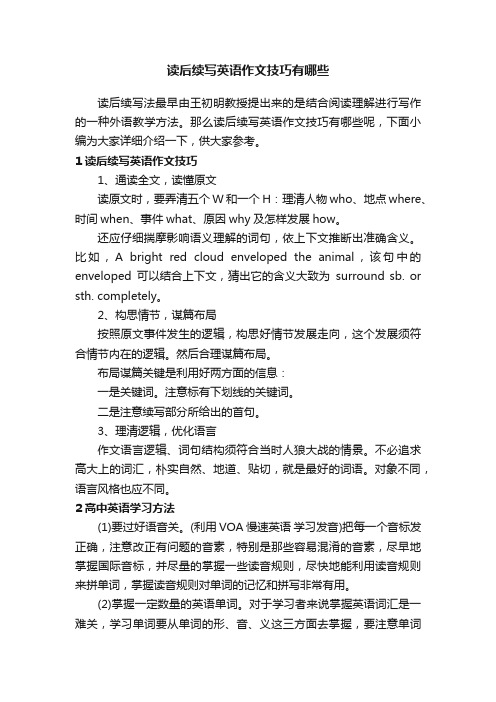
读后续写英语作文技巧有哪些读后续写法最早由王初明教授提出来的是结合阅读理解进行写作的一种外语教学方法。
那么读后续写英语作文技巧有哪些呢,下面小编为大家详细介绍一下,供大家参考。
1读后续写英语作文技巧1、通读全文,读懂原文读原文时,要弄清五个W和一个H:理清人物who、地点where、时间when、事件what、原因why及怎样发展how。
还应仔细揣摩影响语义理解的词句,依上下文推断出准确含义。
比如,A bright red cloud enveloped the animal,该句中的enveloped可以结合上下文,猜出它的含义大致为surround sb. or sth. completely。
2、构思情节,谋篇布局按照原文事件发生的逻辑,构思好情节发展走向,这个发展须符合情节内在的逻辑。
然后合理谋篇布局。
布局谋篇关键是利用好两方面的信息:一是关键词。
注意标有下划线的关键词。
二是注意续写部分所给出的首句。
3、理清逻辑,优化语言作文语言逻辑、词句结构须符合当时人狼大战的情景。
不必追求高大上的词汇,朴实自然、地道、贴切,就是最好的词语。
对象不同,语言风格也应不同。
2高中英语学习方法(1)要过好语音关。
(利用VOA慢速英语学习发音)把每一个音标发正确,注意改正有问题的音素,特别是那些容易混淆的音素,尽早地掌握国际音标,并尽量的掌握一些读音规则,尽快地能利用读音规则来拼单词,掌握读音规则对单词的记忆和拼写非常有用。
(2)掌握一定数量的英语单词。
对于学习者来说掌握英语词汇是一难关,学习单词要从单词的形、音、义这三方面去掌握,要注意单词的一词多义,一词多类的用法,要学会一些构词法的知识,来扩展词汇量。
学习单词要在语言材料中去学,要结合词组,通过句子,阅读文章来活记单词,死记的单词是记不牢的。
坚持在读、说前,先反复听,听的时候反应单词、句子的意思和节奏,想一下单词的拼法、句子结构。
并要同学习语法规则有机结合起来进行。
读后续写写作教程

读后续写写作教程标题:写作教程:从阅读到续写导语:阅读是写作的基础,而续写则是将阅读经验转化为创作力的过程。
本文将为大家介绍一些阅读后续写的技巧和方法,帮助你提升写作水平,培养创造力。
一、选择合适的阅读材料选择合适的阅读材料对于后续写作至关重要。
可以选择自己感兴趣的小说、故事、报告、文章等,确保你对所阅读的内容有一定的了解和兴趣。
这样能够更好地激发你的创作灵感。
二、深度阅读在阅读过程中,要进行深度阅读,而不是仅仅停留在表面的理解。
要仔细分析作者的观点、情感、语言运用等,理解作者的写作意图和技巧。
这样可以更好地吸收阅读材料中的精华,为后续写作打下坚实的基础。
三、提炼主题和要点在阅读过程中,要学会提炼主题和要点。
主题是整个阅读材料的核心思想,要点是支持主题的关键信息和论据。
将主题和要点提炼出来,可以帮助你更好地把握文章的结构和逻辑。
四、思考延伸和续写在阅读结束后,可以思考如何延伸和续写。
可以从以下几个方面展开思考:1. 对主题的深入思考:主题是否还有其他的解读和延伸?可以通过改变视角、加入个人经历等方式来深化对主题的理解。
2. 对角色和情节的续写:可以对阅读材料中的角色和情节进行续写,设想他们的未来发展、补充他们的背景故事等,增加故事的延续性和丰富性。
3. 对结局的设想和改写:可以设想不同的结局,加入自己的创造力和想象力,改写原来的结局,使故事更加有趣和令人惊喜。
五、多练习和反馈要提高续写能力,就需要多练习和不断接受反馈。
可以选择练习续写短篇故事、小说、文章等,不断锻炼自己的创作能力。
同时,可以向他人请教、接受他人的建议和意见,不断改进和提高自己的续写水平。
结语:阅读后续写是提高写作能力和培养创造力的有效方法。
通过选择合适的阅读材料、深度阅读、提炼主题和要点、思考延伸和续写,以及多练习和反馈,你将能够在续写中展现出自己的才华和创造力。
希望本文的写作教程能够对你有所帮助,让你在写作的道路上越走越远。
英语读后续写的方法和技巧_概述及解释说明

英语读后续写的方法和技巧概述及解释说明1. 引言1.1 概述英语读后续写是一种提高英语写作能力的训练方法,通过阅读他人已完成的文章或故事,然后根据所读内容进行创作延续。
它可以帮助我们拓展思维、增加词汇量、培养想象力和改进英语表达能力。
在这个信息爆炸的时代,英语读后续写作为一种有趣和实用的学习方式,在学生中越来越受欢迎。
1.2 文章结构本文将会分为五个主要部分进行介绍和讨论。
首先,引言部分将对英语读后续写进行概述,并解释本文结构。
其次,我们将详细探讨英语读后续写的方法和技巧,包括什么是英语读后续写以及为什么要进行这样的活动等内容。
第三部分将介绍具体的步骤,以便读者可以更好地掌握如何进行英语读后续写。
接下来,我们将针对实践中常见问题提出解决方法,并分享如何克服缺乏创造力、处理文体风格转换和提高词汇量等问题。
最后,在结论部分我们将总结英语读后续写的重要性和价值,并提出对进一步研究和实践的建议。
1.3 目的本文的目的主要有两个方面。
首先,我们旨在介绍英语读后续写的方法和技巧,帮助读者了解什么是英语读后续写以及为何要进行这样的活动。
其次,我们希望通过详细讲解具体步骤和解决常见问题,能够引导读者更好地掌握英语读后续写,并提供相关的实践建议。
通过阅读本文,读者将能够全面了解并运用英语读后续写来提高自己的英语写作能力。
2. 英语读后续写的方法和技巧:2.1 什么是英语读后续写:英语读后续写是一种学习方法,指的是在阅读完一篇文本之后,通过延续原文的思路或情节来进行创作。
这样可以锻炼我们的语言表达能力、扩展想象力,并提高对英语语法和词汇运用的理解。
2.2 为什么要进行英语读后续写:进行英语读后续写有以下几个重要原因。
首先,它能够培养我们对于文本的理解能力,通过思考如何延续故事情节或发展新的观点,我们可以更好地把握文章主题和内容。
其次,英语读后续写可以激发创造力和想象力,在书面表达中体现出自己独特的观点和风格。
此外,通过持续地进行英语读后续写,我们可以提高自己的写作能力,并且加深对于英文句子结构、单词用法以及修辞手法等方面的认识。
读后续写三个微技能训练
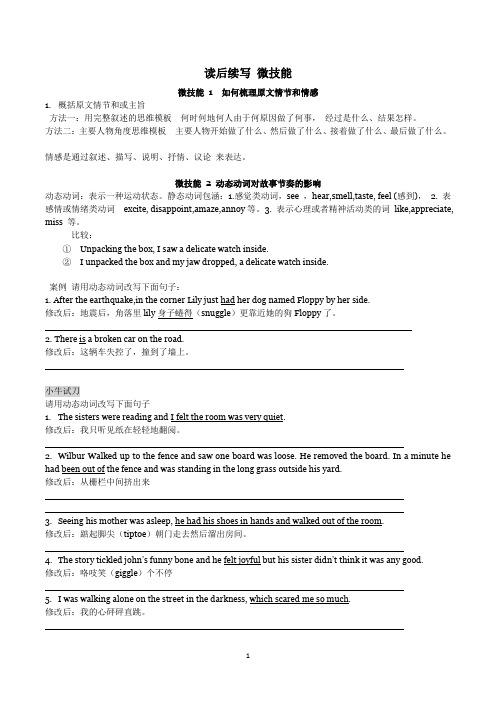
读后续写微技能微技能 1 如何梳理原文情节和情感1.概括原文情节和或主旨方法一:用完整叙述的思维模板何时何地何人由于何原因做了何事,经过是什么、结果怎样。
方法二:主要人物角度思维模板主要人物开始做了什么、然后做了什么、接着做了什么、最后做了什么。
情感是通过叙述、描写、说明、抒情、议论来表达。
微技能 2 动态动词对故事节奏的影响动态动词:表示一种运动状态。
静态动词包涵:1.感觉类动词,see ,hear,smell,taste, feel (感到),2. 表感情或情绪类动词excite, disappoint,amaze,annoy等。
3. 表示心理或者精神活动类的词like,appreciate, miss 等。
比较:①Unpacking the box, I saw a delicate watch inside.②I unpacked the box and my jaw dropped, a delicate watch inside.案例请用动态动词改写下面句子:1.After the earthquake,in the corner Lily just had her dog named Floppy by her side.修改后:地震后,角落里lily身子蜷得(snuggle)更靠近她的狗Floppy了。
2.There is a broken car on the road.修改后:这辆车失控了,撞到了墙上。
小牛试刀请用动态动词改写下面句子1.The sisters were reading and I felt the room was very quiet.修改后:我只听见纸在轻轻地翻阅。
2.Wilbur Walked up to the fence and saw one board was loose. He removed the board. In a minute he had been out of the fence and was standing in the long grass outside his yard.修改后:从栅栏中间挤出来3.Seeing his mother was asleep, he had his shoes in hands and walked out of the room.修改后:踮起脚尖(tiptoe)朝门走去然后溜出房间。
英语读后续写技巧与策略

12.物质与非物质文化遗产;
13.社会热点问题;
科学与技术 14.重大政治,历史事件,文化渊源;
15.社会进步与人类文明
16.科技发展与信息技术创新,科学精神,信息安全。
2024高考续写可能怎么考?
主题语境
主题群
主题语境内容要求
1.主要国家地理概况;
人
自然生态 环境保护
2.自然环境,自然遗产保护; 人与环境,人与动植物;
5W1H,即短文涉及的人物(Who)、地点(Where)、时间
(When)、事件(What)、原因(Why)以及发展过程
(How),重点引导学生把握事件的经过(How)以及原因和
前后联系(Why)。从人物和故事情节中找出冲突,进而合理
推测出文章的中心思想和主要内容。
方法⑵ 依据时空线索,分析主要情节
– 例 2022年新高考I卷
...David had not missed a single practice,and although he always finished his run after the other children,he did always finish. As a special education teacher at the school .I was famaliar with the challenges David faced and was proud of his strong deterimination.
题型 解读
读后续写是随着我国高考改革由教育部考试中心研 制的英语高考新题型,2016年10月在浙江省首次使 用。该题型通过读写结合,检测学生的英语书面语言 理解与表达能力。要求学生能够梳理故事文体的结构、 分析故事发展的线索、想象故事发展的情节以及续写 故事的发展和结局。
英语读后续写技巧
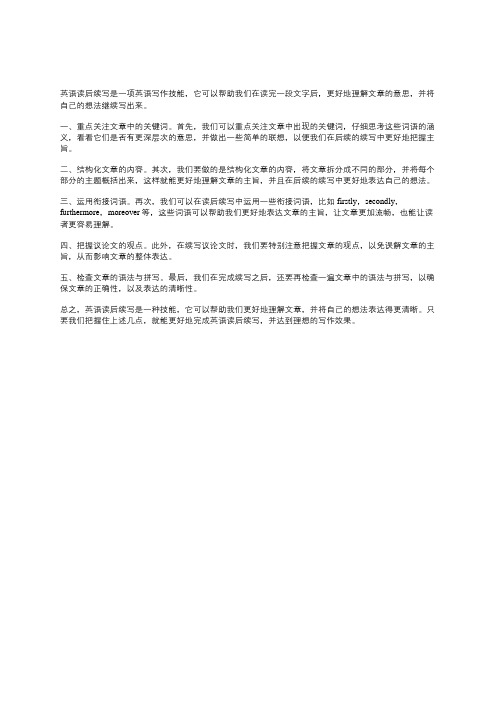
英语读后续写是一项英语写作技能,它可以帮助我们在读完一段文字后,更好地理解文章的意思,并将自己的想法继续写出来。
一、重点关注文章中的关键词。
首先,我们可以重点关注文章中出现的关键词,仔细思考这些词语的涵义,看看它们是否有更深层次的意思,并做出一些简单的联想,以便我们在后续的续写中更好地把握主旨。
二、结构化文章的内容。
其次,我们要做的是结构化文章的内容,将文章拆分成不同的部分,并将每个部分的主题概括出来,这样就能更好地理解文章的主旨,并且在后续的续写中更好地表达自己的想法。
三、运用衔接词语。
再次,我们可以在读后续写中运用一些衔接词语,比如firstly,secondly,furthermore,moreover等,这些词语可以帮助我们更好地表达文章的主旨,让文章更加流畅,也能让读者更容易理解。
四、把握议论文的观点。
此外,在续写议论文时,我们要特别注意把握文章的观点,以免误解文章的主旨,从而影响文章的整体表达。
五、检查文章的语法与拼写。
最后,我们在完成续写之后,还要再检查一遍文章中的语法与拼写,以确保文章的正确性,以及表达的清晰性。
总之,英语读后续写是一种技能,它可以帮助我们更好地理解文章,并将自己的想法表达得更清晰。
只要我们把握住上述几点,就能更好地完成英语读后续写,并达到理想的写作效果。
高中英语读后续写与概要写作 技能三 如何提炼关键词

微技能三如何提炼关键词60词左右的概要不允许照搬含有主题和支持性信息的原句。
为了使独立表达成为可能,你必须学会提炼关键词,提取关键词主要考查学生概括思想内容,提取关键信息的能力。
说到底就是要善于提取“核心信息”,善于提炼恰当的词语来表达内容。
关键词一般是名词、动词、形容词,不会是虚词。
1.“提炼”是一个弃芜存精....的过程,因此要做到精炼,也就是说提炼的结果是获取最精要的文字。
2.首先要结合主旨大意,选取与文本主旨密切相关的词语。
它们通常是名词(短语)、动词(短语)和形容词(短语)等实词。
这些实词有可能以原词、代词、同义词、近义词或反义词的形式重复出现,但提炼时不能重复关键词。
3.提取关键词时,必须注意句子间的关系。
不要在表达相同或相近含义的句子里重复提取关键词,如议论文的段落中常有主题句和结论句,结论句通常用不同的表达方式重申主题句的含义,因此没必要在结论句中再次提取关键词。
4.就主从复合句而言,关键词通常在主句部分,而非从句部分,但含有宾语从句的主从复合句例外,关键词应在宾语从句部分。
【典例示范】1.画出该段的主题句。
2.根据主题句,画出关键词。
【即时演练】画出本文的主题句和关键词。
Human beings are smart.However, it seems that people are gradually losing their smartness as smartphones become more and more important assistants in their lives, reported news website Record Japan on Oct.22.As we rely too much on technology instead of our brains, many people have lost three basic abilities, said the website. The first skill many people have lost is remembering phone numbers.Because phone numbers are stored in smartphone contacts, there is no need to dial a number or look at it again.And people may also have lost their sense of direction because navigation apps can guide people anywhere they want to go.These apps can even find shortest routes for you and avoid traffic jams.But the worst lost skills may be social ones,meaning that some people are becoming socially inept(无能的).People often bury themselves in their smart-phones.As we are too addicted to what’s happening in the virtual world,some of us have lost conversational skills and sometimes can’t even tell whether a person is happy or not.Luckily, people still have a chance to get these abilities back.You should try to keep your parents’ number in mind for emergencies.You should also pay more attention to street signs and stores, which will help you to draw a mind map and prevent you from getting lost.And the easiest solution to social skill loss is to take a break from electronic devices because we are social creatures.We need device-free time.答案主题句:However, it seems that people are gradually losing their smartness as smartphones become more and more important assistants in their lives.关键词:lost three basic abilities,remembering phone numbers,have a chance to get these abilities back,device-free time.。
高考英语专题复习:读后续写+概要写作 答题技巧指导
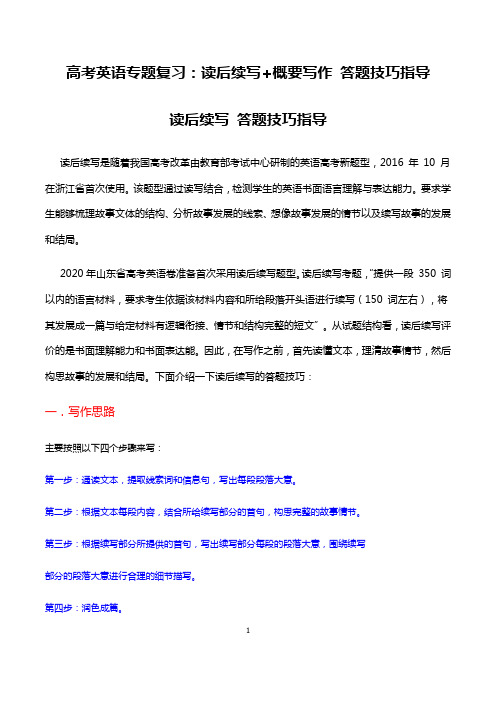
高考英语专题复习:读后续写+概要写作答题技巧指导读后续写答题技巧指导读后续写是随着我国高考改革由教育部考试中心研制的英语高考新题型,2016 年10 月在浙江省首次使用。
该题型通过读写结合,检测学生的英语书面语言理解与表达能力。
要求学生能够梳理故事文体的结构、分析故事发展的线索、想像故事发展的情节以及续写故事的发展和结局。
2020年山东省高考英语卷准备首次采用读后续写题型。
读后续写考题,“提供一段350 词以内的语言材料,要求考生依据该材料内容和所给段落开头语进行续写(150 词左右),将其发展成一篇与给定材料有逻辑衔接、情节和结构完整的短文”。
从试题结构看,读后续写评价的是书面理解能力和书面表达能。
因此,在写作之前,首先读懂文本,理清故事情节,然后构思故事的发展和结局。
下面介绍一下读后续写的答题技巧:一.写作思路主要按照以下四个步骤来写:第一步:通读文本,提取线索词和信息句,写出每段段落大意。
第二步:根据文本每段内容,结合所给续写部分的首句,构思完整的故事情节。
第三步:根据续写部分所提供的首句,写出续写部分每段的段落大意,围绕续写部分的段落大意进行合理的细节描写。
第四步:润色成篇。
1二.写作过程展示阅读下面材料,根据其内容和所给段落开头语续写两段,使之构成一篇完整的短文。
续写的词数应为150左右。
It was somewhere between spring and summer that my mom and I were driving through the countryside. Back then I was 13 years old and always felt unhappy with Mom. But little did I know that this trip was going to be a special one.A pot of flowers sat in the back seat, whose heavenly scent filled the car. Suddenly, in the middle of nowhere, my mom pulled over. “What are you doing?”I cried, fearing that the car had broken down and we’d be stuck there, so far from home. But that wasn’t the case. My mom hopped out of the car, grabbing the flowers from the back seat. “It’ll just be a minute,”she called back through the open windows.My eyes impatiently skimmed the edge of the road before settling on a little sign showing that it was a nursing home (养老院). I looked back at the building, somewhat annoyed, as my mom reappeared, empty-handed.Before she started the car, curiosity drove me to ask, “Do you know anyone there?”She shook her head. “Then what did you do with the flowers?”She smiled slightly, “I gave them to the receptionist (接待员).”“What?”She laughed at my confusion. “I told the receptionist to give the flowers to whoever needed them, especially those who haven’t gotten any.”2I kept silent for a moment. Not long after we continued our driving, I spoke again, “Did you leave your name?”To this she answered instantly, “No. Leaving flowers there for someone who will appreciate them makes me feel good, which is enough.”Suddenly, still thinking about Mom’s deeds, I heard something burst loudly. It was our car that broke down! Nothing could be worse, because neither my mom nor I understood how to repair it, and we didn’t know where the garage (汽车修理厂) was. It also seemed impossible to wait for any passerby, since we had seen so few along the way.Paragraph 1:We were worrying about what could be done.Paragraph 2:As we drove along, a flower shop came into sight.【写作思路】第一步:通读文本,提取线索词和信息句,写出每段段落大意。
读后续写与概要写作微技能三 运用四种手段 做到生动描述

But no more helicopters came and it was getting dark again. Jane was so tired, hungry, and extremely frightened.
文中的动作和神情描写:lying,fell asleep, held her breath, slept,flew overhead, helped
Paragraph 1: But no more helicopters came and it was getting dark again.
Paragraph 2: It was daybreak when Jane woke up.
参考范文
写作启示
Paragraph 1:
1.动作和神情描写
【典例示范】(2016·10月浙江卷改编) 阅读下面材料,根据其内容和所给段落开头语续写两段,使之构成一篇完整的短
读后续写素材积累词汇

读后续写素材积累词汇摘要:一、引言二、词汇积累的重要性1.提升写作水平2.丰富表达能力3.增强语言魅力三、读后续写中的词汇运用技巧1.把握角色性格特点2.创设生动场景3.运用修辞手法四、实例分析1.人物性格描写示例1:勇敢果断示例2:内向腼腆2.场景描写示例1:大自然风光示例2:城市街景3.修辞手法运用示例1:比喻示例2:排比五、结论正文:一、引言作为一名职业写手,我们在创作过程中往往需要不断地积累素材和词汇。
读后续写作为一种特殊的写作形式,更需要我们在词汇积累方面下功夫。
本文将为大家介绍如何在读后续写中积累词汇,以及如何在实际创作中运用这些词汇。
二、词汇积累的重要性1.提升写作水平词汇是构成文章的基本元素,丰富的词汇量能让我们在写作时如鱼得水。
通过不断地积累,我们可以提升自己的写作水平,让文章更具吸引力。
2.丰富表达能力词汇积累有助于我们在表达时更加精确、贴切。
掌握更多词汇,可以让我们的表达更加丰富多彩,为文章增色添彩。
3.增强语言魅力词汇丰富的人,语言更具魅力。
在读后续写中,运用多样化的词汇,可以让文章更具吸引力,让读者沉浸其中。
三、读后续写中的词汇运用技巧1.把握角色性格特点在续写过程中,我们要对角色进行细致入微的刻画。
掌握角色的性格特点,运用恰当的词汇来描绘,使角色更具立体感。
2.创设生动场景读后续写中,场景描写是不可或缺的部分。
我们可以运用丰富的词汇来描绘场景,让读者身临其境。
3.运用修辞手法修辞手法能使文章更具表现力。
在续写过程中,我们可以适当运用比喻、排比等修辞手法,提升文章的语言韵味。
四、实例分析1.人物性格描写(1)勇敢果断例如:她毫不犹豫地挺身而出,勇敢地面对危险,用实际行动证明了自己的勇敢和果断。
(2)内向腼腆例如:她总是腼腆地低着头,说话细声细气,给人一种温柔的感觉。
2.场景描写(1)大自然风光例如:阳光穿过茂密的树林,洒在青青的草地上,小溪潺潺,鸟儿欢快地歌唱着。
(2)城市街景例如:繁华的都市夜景,霓虹闪烁,车水马龙,行人络绎不绝。
英语读后续写关键词的功能及其选择方略
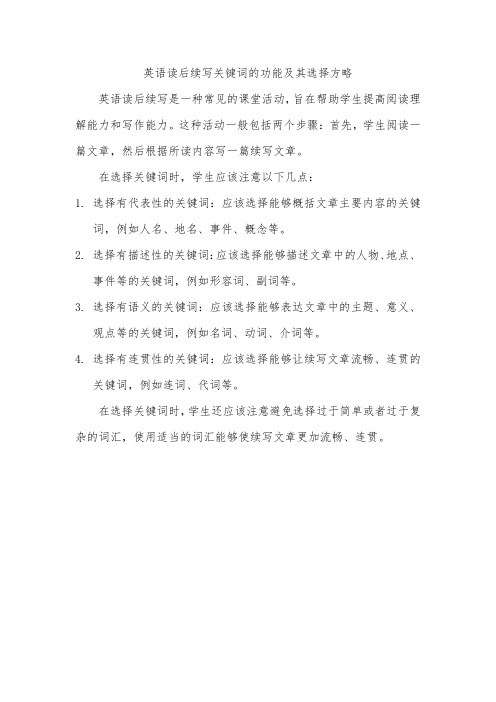
英语读后续写关键词的功能及其选择方略
英语读后续写是一种常见的课堂活动,旨在帮助学生提高阅读理解能力和写作能力。
这种活动一般包括两个步骤:首先,学生阅读一篇文章,然后根据所读内容写一篇续写文章。
在选择关键词时,学生应该注意以下几点:
1.选择有代表性的关键词:应该选择能够概括文章主要内容的关键
词,例如人名、地名、事件、概念等。
2.选择有描述性的关键词:应该选择能够描述文章中的人物、地点、
事件等的关键词,例如形容词、副词等。
3.选择有语义的关键词:应该选择能够表达文章中的主题、意义、
观点等的关键词,例如名词、动词、介词等。
4.选择有连贯性的关键词:应该选择能够让续写文章流畅、连贯的
关键词,例如连词、代词等。
在选择关键词时,学生还应该注意避免选择过于简单或者过于复杂的词汇,使用适当的词汇能够使续写文章更加流畅、连贯。
高中英语读后续写素材积累方法

高中英语读后续写素材积累方法在英语学习中,读后续写是一种常见的写作训练方式,也是高考英语的重要考查题型。
要想在读后续写中取得好成绩,素材积累是非常关键的。
那么,高中英语读后续写素材积累方法有哪些呢?下面就针对这一问题进行详细分析,希望能够帮助大家更好地进行素材积累。
一、注重词汇积累词汇是构成语言的基本要素,要想在读后续写中取得好成绩,必须要有丰富的词汇积累。
在平时的学习中,要注重词汇的积累,可以准备一个笔记本,将阅读中遇到的一些好词佳句摘抄下来,并经常翻阅记忆,这样能够增加词汇量,为读后续写打下坚实的基础。
二、关注句式积累句式是构成文章的基本框架,句式的选择和使用对于读后续写的帮助是非常大的。
在平时的学习中,要注重句式的积累,可以从以下几个方面入手:1. 复杂句式的使用。
复杂句式能够让续写的句子更加生动、丰富,可以运用一些从句或者非谓语动词等语法知识,让句子更加高级。
2. 巧用并列句。
并列句能够让续写的句子更加有条理、有层次,可以根据语境的需要运用一些并列连词,如and、or、but等来连接并列句。
3. 多运用倒装句。
倒装句能够使续写的句子更加有节奏感,而且使用得当还能够增加句子的亮点。
三、注重语篇积累语篇是构成文章的基本单位,语篇的理解和把握对于读后续写至关重要。
在平时的学习中,要注重语篇的积累,可以从以下几个方面入手:1. 多阅读一些优秀的范文。
优秀的范文能够为续写提供很好的范例,而且范文中一些好的衔接词、过渡句等都能够为续写提供很好的启示。
2. 注重语篇结构的分析。
语篇结构是构成文章的基本框架,不同的语篇结构表达的意思和情感也是不同的。
因此,在平时的学习中,要注重分析语篇结构,掌握各种语篇结构的表达方式和特点。
四、注重情感积累情感是构成文章的重要元素,情感的理解和表达对于读后续写也是非常重要的。
在平时的学习中,要注重情感的积累,可以从以下几个方面入手:1. 多阅读一些情感丰富的文章。
情感丰富的文章能够为续写提供很好的情感基础,而且通过阅读能够更好地理解作者的情感表达方式。
读后续写和概要写作讲义 概要写作之要点提炼

概要写作之要点提炼Nowadays, more and more college students have no problem walking into a classroom and opening their laptops. Others may spend an entire study period with a smartphone in hand. Some people argue that the increasing use of technology can have many helpful effects on society. But a recent research suggests that using technology during class time may harm college students' ability to remember and process the subject material.Arnold Glass, a professor in Rutgers University in New Jersey4, and a student researcher investigated the issue of divided student attention. The study involved 118 Rutgers students who were taking the same level college class. The students were permitted to use any electronic device during half of their daily class periods. During the other half, no one was allowed to use any technology.The researchers found that the average daily quiz results showed no evidence of harmful effects from the use of technology. However, the average results of the larger tests and final exam showed that all the students performed poorly when they were permitted to use technology in the classroom. Glass argues that it shows the use of electronic devices in the classroom prevent students from processing information. When the students hear what the professor is saying, they might be buying things online or reading unrelated emails at the same time. And that, Glass says, makes it harder for the information to enter their long term memory. Even though the students know what the professor said at that time, they no longer remember it a week later because they missed the opportunity. However, Lauren Margulieux, an assistant professor at Georgia State University in Atlanta argues that there are times when classroom use of technology is unavoidable. So, he says, educators need to consider that something other than technology is distracting students.In fact, a special software program has been created. Students can use the program, which engages students more with the class material on their personal devices during a given class. It can also be used to observe student activity and prevent them from opening unrelated pages and programs. Learning steps:1. What’s the writing style of the passage?A. exposition (说明文)B. argumentation(议论文)C. narration(记叙文)The author points out the about ______________________________and the ______________ to it.4. Read for the main point of each paragraph (underline it)5.Rewrite point1:________________________________________________________________ ________________________________________________________________________________6. Keep the following in mind:_________________________________________________________________________________ _________________________________________________________________________________ ______________________________________________________________________________ Homework: rewrite the summary.。
新概念读后续写技巧与方法大全

新概念读后续写技巧与方法大全一、了解作者意图1. 仔细阅读原文,理解作者的用词和句式,掌握作者的思想和表达方式。
2. 寻找文章的中心思想,明确作者想传达的主题和观点。
二、把握文章结构1. 分析原文的结构,找出开头、中间、结尾的逻辑关系和延伸线索。
2. 确定文章的主线和次线,分清重点和次要内容。
三、提炼关键词语1. 通过阅读原文,找出作者提到的重要词语和概念。
2. 对关键词进行归纳和总结,梳理文章的要点和重要信息。
四、拓展联想思维1. 运用自己的想象和联想,拓展文章的主题和内涵,进行深入的思考和探索。
2. 与自己的经验、知识和生活通联起来,进行个人化的联想和思考。
五、记录笔记和思维导图1. 将关键词和重要句子用笔记本记录下来,方便后续写时参考和运用。
2. 利用思维导图工具,将文章的结构和关键点用图形化方式呈现,形成清晰的思维框架。
六、多维度思考与表达1. 透过作者的视角思考问题,换位思考,站在不同的角度分析问题。
2. 通过比喻、引用、对比等手法丰富文章的表达和思维深度,增加文章的丰富性和吸引力。
七、细节处理及语言表达1. 注意细节处理,对原文中的细节进行展开解释或补充说明,让文章更加具体生动。
2. 精准选择用词和句式,保持文章的语言精准和流畅,让读者理解和接受。
八、优化篇幅与逻辑1. 在保证完整表达的前提下,尽可能使用简洁明了的语言表达,避免赘述和啰嗦。
2. 结构合理,层次清晰,保持文章的逻辑性和连贯性。
九、反复思考和修改1. 完成初稿后,进行反复推敲和修改,不断修正不足之处,提高文章的质量和表达效果。
2. 相互交流和学习,共享自己的作品,听取他人的意见和建议,不断提高写作水平。
在学习新概念读后续写技巧与方法时,还需要注意以下几点:十、立足现实生活1. 将文章的主题与现实生活通联起来,让读者更容易产生共鸣和理解。
2. 利用生动的描写和具体的事例,增强文章的说服力和感染力。
十一、加强逻辑推理1. 在阅读原文的基础上,进行逻辑推理和思维分析,让文章具备逻辑推理的能力和深度。
高中英语读后续写微技能探究

高中英语读后续写微技能探究读后续写是一种锻炼英语写作技能的有效方法。
它可以帮助学生理解原文,培养写作能力,同时提高语言表达能力。
在这篇文章中,我将关注读后续写的微技能,包括如何理解原文,如何构思及写作等方面。
一、理解原文在进行读后续写之前,首先要理解原文的内容。
理解原文可以帮助读者更好地把握主题和思想,从而更好地进行续写。
下面是一些方法:1.重点阅读可以先快速浏览全文,然后再仔细阅读,注意标点符号和语气。
在阅读时可以圈出重要字句,这些关键字将有助于我们理解文章的主题。
2.概括主题读完全文后,可以概括出文章的主题和内容,同时也要注意文章的结构和段落。
这有助于我们更好地理解文章,为后续写作做好准备。
3.理解作者的思想在理解文章内容的同时,还要注意作者的思想和态度。
这些思想和态度将帮助我们更好地理解文章,并在后续写作时保持一致。
二、构思进行构思是读后续写的关键步骤之一。
它需要读者将原文中的想法扩展和发展出自己的想法,同时要注意风格和语气。
以下是几点建议:1.扩展想法在构思时,可以根据原文中的想法和思路,发展自己的想法并加以拓展。
这样有助于使我们的读后续写更具有独创性。
2.考虑语气和风格在构思时,要注意语气和风格。
原文中的语气和风格会影响我们的写作。
比如,如果原文的风格是诙谐幽默的,我们在续写时也要保持这种风格。
3.构思一个概要在构思时,可以通过构思一个概要来完善自己的思路。
这样可以让我们更好地组织文章,使之更有条理性。
三、写作构思完成后,接下来就是写作的阶段。
以下是几点建议:1.遵循结构在写作时,要遵循文章的结构和段落。
这有助于使文章更具可读性,同时也是表现自己写作能力的机会。
2.保持逻辑性写作时要保持逻辑性,并注意过渡和连接。
这有助于使文章内容更流畅,也有助于保持同一主题的一致性。
3.复读和修改在完成第一稿后,可以复读和修改文章。
这样可以帮助我们检查文章的语言、语法和拼写等,同时也有助于提高写作技能。
例谈读后续写中关键词的使用策略

例谈读后续写中关键词的使用策略发布时间:2021-09-07T08:37:20.325Z 来源:《教育学文摘》2021年5月13期作者:潘优燕[导读] 读后续写将阅读与写作有机地结合在一起,阅读和写作在同一语境中产生互动,是一种“为写而读、以读促写”的写作形式。
潘优燕浙江省仙居中学317300【摘要】读后续写将阅读与写作有机地结合在一起,阅读和写作在同一语境中产生互动,是一种“为写而读、以读促写”的写作形式。
本文以2017年11月份浙江省英语高考真题为例,提出了读后分类关键词,通过造句联想故事情节、写前分配关键词,激活话题词汇和表达、写中回顾关键词,模仿创造语言、写后检查关键词的策略。
【关键词】读后续写;为写而读;以读促写;话题;关键词一.引言读后续写通常为故事类文本,其话题贴近生活,有一定的趣味性,想象空间大,且情节发展具有较强逻辑性(刘庆思、陈康2016)。
读后续写把阅读的语言输入和写作的语言输出整合在同一语境中,为学生提供模仿并运用所学语言的机会,有利于培养学生的创造性思维(凌勇,2016)。
这种“为写而读、以读促写”的写作形式在一定程度上改变了过去“为读而读、只读不写”的粗放型阅读方式。
在读后续写的教学中,很多教师能帮助学生理清原文思路,获取文本的主要信息,并根据两个段首语进行构思续写。
但是对于10个划线的关键词缺少研究和有效的指导。
本文将以2017年11月的浙江省英语高考真题(以下简称“11月真题”)为例,提出读后续写关键词的使用策略。
二、关键词的使用策略关键词有助于获取短文主要信息和预测续写情节发展的作用。
笔者在读后续写教学中对学生进行了续写关键词的使用策略指导,现以“11月真题”为例,阐述关键词的使用方法。
1.读后分类关键词,通过造句联想故事情节这是一篇记叙文,要求学生读完原文后,按记叙文的相关要素分类关键词。
“11月真题”提供了以下十个关键词:absent-minded, forgetful, trip, David, camping, tent, Mom, Dad, trouble, nice. 笔者指导学生按记叙文的相关要素分类如下(见表1)表1 按记叙文的相关要素关键词的分类通过关键词造句的方法来帮助学生在脑海中浮现出故事情节,合乎逻辑地进行细节推测,为后面的续写做好准备。
- 1、下载文档前请自行甄别文档内容的完整性,平台不提供额外的编辑、内容补充、找答案等附加服务。
- 2、"仅部分预览"的文档,不可在线预览部分如存在完整性等问题,可反馈申请退款(可完整预览的文档不适用该条件!)。
- 3、如文档侵犯您的权益,请联系客服反馈,我们会尽快为您处理(人工客服工作时间:9:00-18:30)。
2.首先要结合主旨大意,选取与文本主旨密切相关的词语。它们通常是名词(短语)、 动词(短语)和形容词(短语)等实词。这些实词有可能以原词、代词、同义词、近义 词或反义词的形式重复出现,但提炼时不能重复关键词。
3.提取关键词时,必须注意句子间的关系。不要在表达相同或相近含义的句子里重 复提取关键词,如议论文的段落中常有主题句和结论句,结论句通常用不同的表 达方式重申主题句的含义,因此没必要在结论句中再次提取关键词。
微技能三 如何提炼关键词
60词左右的概要不允许照搬含有主题和支持性信息的原句。为了使独立表达成为 可能,你必须学会提炼关键词,提取关键词主要考查学生概括思想内容,提取关键信 息的能力。说到底就是要善于提取“核心信息”,善于提炼恰当的词语来表达内容。 关键词一般是名词、动词、形容词,不会是虚词。 1.“提炼”是一个弃.芜.存.精.的过程,因此要做到精炼,也就是说提炼的结果是获取最
lying will try to look at you in a strong way
词有“not look you in the eye”和“look
because they want to convince you they are
at you in a strong way”,因此它们可
telling the truth.If someone does either of these 以作为关键词支持上面这个主题
two things thLeabharlann y might be lying.
句。
【即时演练】 画出本文的主题句和关键词。
Human beings are smart.However, it seems that people are gradually losing their smartness as smartphones become more and more important assistants in their lives, reported news website Record Japan on Oct.22.As we rely too much on technology instead of our brains, many people have lost three basic abilities, said the website.
The first skill many people have lost is remembering phone numbers.Because phone numbers are stored in smartphone contacts, there is no need to dial a number or look at it again.And people may also have lost their sense of direction because navigation apps can guide people anywhere they want to go.These apps can even find shortest routes for you and avoid traffic jams.But the worst lost skills may be social ones,meaning that some people are becoming socially inept( 无 能 的 ) . People often bury themselves in their smartphones.As we are too addicted to what’s happening in the virtual world,some of us have lost conversational skills and sometimes can’t even tell whether a person is happy or not.
4.就主从复合句而言,关键词通常在主句部分,而非从句部分,但含有宾语从句的 主从复合句例外,关键词应在宾语从句部分。
【典例示范】 1.画出该段的主题句。 2.根据主题句,画出关键词。
Sometimes you can tell if a person is lying
主题句的主旨大意是通过观察
by observing what they do with their body.
“what they do with their body”来判断
Sometimes a person who is lying will not look 一个人是否在撒谎。下面的支持性
you in the eye.Other times the person who is 信息里和该主旨大意密切相关的实
答案 主题句:However, it seems that people are gradually losing their smartness as smartphones become more and more important assistants in their lives. 关键词: lost three basic abilities,remembering phone numbers,have a chance to get these abilities back,device-free time.
Luckily, people still have a chance to get these abilities back.You should try to keep your parents’ number in mind for emergencies.You should also pay more attention to street signs and stores, which will help you to draw a mind map and prevent you from getting lost.And the easiest solution to social skill loss is to take a break from electronic devices because we are social creatures.We need device-free time.
